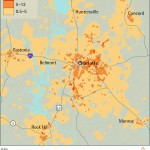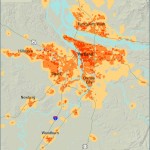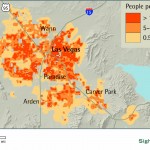Search Results
-
Measure: What Matters
There’s a great article in today’s Washington Post on Oregon’s Measure 37, the voter-approved initiative that is threatening to unravel the state’s anti-sprawl laws. To recap, Measure 37 requires the government to compensate anyone whose land value has been reduced by Oregon’s successful growth management programs—making those programs vastly more expensive and complicated to implement. To me, the most interesting point made by the article is that Measure 37 claims...Read more » -
Charlotte, NC-area Population Density
Charlotte, NC, is the most sprawling of 12 non-Cascadian cities studied in the report: The Portland Exception.Read more » -
Portland-area Population Density
Portland has excelled in recent years at protecting rural land from suburban development.Read more » -
Las Vegas-area Population Density
Of the 12 non-Cascadian cities studied by Sightline, greater Las Vegas is the densest, with half of its residents living in compact communities in 2000.Read more » -
Walking the Walk
An article in today’s Vancouver Sun (subscription required) reports on a new study showing that, in neighborhoods that are designed to make walking convenient, people do, in fact, walk more. To wit: People who lived the most walkable neighborhoods were 2.4 times as likely to walk for 30 minutes or more than those who lived in the least walkable communities. The study’s authors, led by UBC professor Lawrence Frank, defined...Read more » -
A Study in Contrasts
So Seattle’s Montlake neighborhood just unveiled a proposal to replace the 520 floating bridge across Lake Washington with a project whose centerpiece, according to the Seattle P-I, would be… a suspension bridge that would soar from near Interstate 5 over Portage Bay and Montlake and then descend to a new floating bridge on Lake Washington…. Neighborhood residents who overflowed a building at Montlake Park on Wednesday night were enthusiastic about...Read more » -
Tunnel Vision?
(This post is part of a series.) A while back, the Seattle city government decided that it wanted to replace the Alaskan Way Viaduct—the seismically vulnerable aerial highway that cuts off the city’s downtown from its waterfront—with a tunnel. But what neither the city, nor anyone else, has decided is how to pay for the tunnel, which the state estimates could cost more than $4 billion. So far, the city...Read more » -
Commuting Sentences
Pop quiz: What share of personal trips in the U.S. are to or from work? Answer: just 15 percent, or about one out of seven trips. And according to this (somewhat dated) study by the Puget Sound Regional Council, even during the peak afternoon rush hour, only a minority of trips actually take us from work to home. We make lots of different kinds of trips during that time—shopping, school,...Read more » -
Eating Close to Home
Eat Here, a new book by Worldwatch Institute’s Brian Halweil, takes a close look at a topic that is close to many northwesterners’ hearts and taste buds: the burgeoning local food movement. The book is a bit too data-packed-not quite accessible enough for a general audience-but it does have some gems in it, including a series of case studies of communities, businesses, and consumers around the world who are working...Read more » -
Measure for Measure?
A development to watch: the supporters of Oregon’s Measure 37 (which we discussed earlier) are considering moving north, by introducing a similar ballot initiative in Washington. In a nutshell, Measure 37 requires the government to compensate long-time landowners when regulations significantly reduce the value of a particular parcel of land. (Of course, no property owner has to refund money when a government action increases the value of land—but that’s a...Read more »




